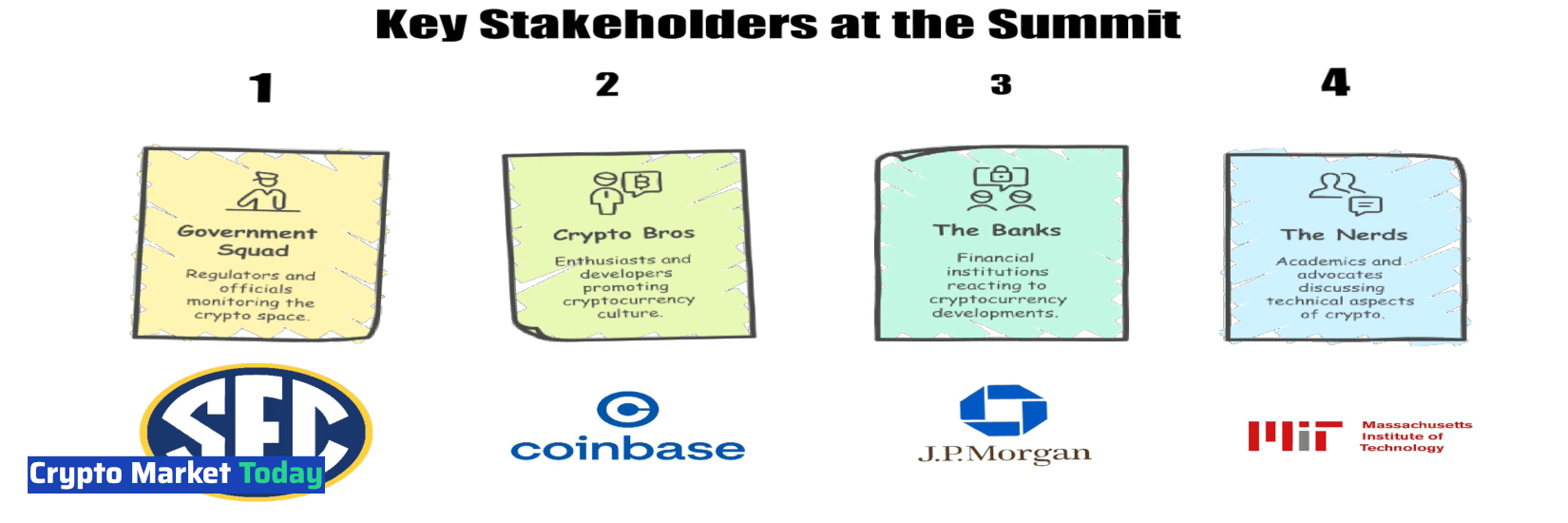Introduction
Navigating the Future of Digital Finance
In recent years, the world has witnessed an unprecedented rise in the adoption and utilization of cryptocurrencies and blockchain technology. What was once considered a niche market has now evolved into a global phenomenon, with the White House taking notice of its significant impact on society.
The crypto revolution has not only transformed the way we think about money and transactions but also has far-reaching implications for various industries, from finance to healthcare. The White House's initiative to address the opportunities and challenges presented by this technological advancement marks a critical juncture in shaping the future of digital finance.
A Critical Moment: The White House Crypto Summit
Against this backdrop, the White House hosted its first-ever crypto summit, bringing together leading experts, policymakers, and industry leaders to foster dialogue on regulation, innovation, and U.S. global leadership. This pivotal event aimed to address the complex issues surrounding cryptocurrencies and blockchain technology, with a focus on harnessing their potential for economic growth and stability.
As we navigate this uncharted territory, it's essential to acknowledge that the White House crypto summit represents more than just a gathering of stakeholders; it signifies a critical moment in shaping the future of finance and technology. The objectives of the summit – to foster dialogue on regulation, innovation, and U.S. global leadership – serve as a testament to the administration's commitment to embracing this technological revolution while ensuring that its benefits are equitably distributed.
In the following sections, we'll delve deeper into the context of the crypto revolution, explore the purpose and objectives of the White House crypto summit, and examine the key takeaways from this pivotal event. Our goal is to provide a comprehensive understanding of this complex topic, making it accessible to both experts and newcomers in the field.
Background: Why Now?

The White House Crypto Summit marked a pivotal moment in the development of digital finance, coming at a time when cryptocurrencies were experiencing unprecedented growth. In recent years, market capitalization has surged, driven by institutional adoption and retail investor enthusiasm.
Market Capitalization Surge: The global cryptocurrency market has grown exponentially, with total market capitalization reaching $3.07 trillion as of March 8, 2025.
Institutional Adoption: Major companies like Tesla and PayPal have invested in cryptocurrencies, further legitimizing their place in the financial landscape.
Retail Investor Boom: Retail investors have shown a unique affinity for cryptocurrencies, driving up demand and fueling growth.
However, this rapid expansion has also created new challenges. Regulatory bodies have struggled to keep pace with the evolving landscape, leading to concerns around security breaches, environmental impact, and fraud cases like the FTX collapse.
The White House Crypto Summit aimed to address these challenges head-on, bringing together industry leaders, administration officials, and lawmakers to shape a clearer regulatory framework for digital finance. As the global competition for dominance in tech and finance intensifies, the U.S. has been urged to take a leading role in establishing a robust and supportive environment for innovation.
China's development of a digital yuan and the EU's MiCA framework have raised the stakes for the U.S., highlighting the need for more comprehensive regulations that balance innovation with investor protection. The White House Crypto Summit marked an important step towards addressing these challenges, but the journey ahead will require continued collaboration and regulatory refinement to ensure the future of digital finance remains secure and inclusive.
Key Stakeholders at White House Crypto Summit

The White House Crypto Summit brought together a diverse group of stakeholders to navigate the future of digital finance. Among them were key representatives from government, industry, and academia.
A. Government Representatives
High-ranking officials from the US government played a significant role in shaping the conversation around digital currencies. These included:
White House advisors: Providing strategic guidance on policy development and implementation.
SEC (Securities and Exchange Commission): Discussing regulatory frameworks for securities trading and investor protection.
Federal Reserve: Exploring the feasibility of central bank digital currencies (CBDCs) and their implications for monetary policy.
Treasury Department: Addressing tax implications, money laundering concerns, and broader economic impact.
These government representatives worked in tandem with industry leaders to ensure a comprehensive understanding of the crypto landscape.
B. Industry Leaders
Representatives from leading crypto firms, banks, and tech giants also contributed significantly to the summit's discussions. These included:
Crypto firms (Coinbase): Sharing insights on user experience, security protocols, and regulatory compliance.
Banks (JPMorgan): Discussing their forays into digital currencies, market access, and risk management strategies.
Tech giants (Meta): Examining the potential of blockchain technology in enhancing data integrity, supply chain management, and cybersecurity.
Industry leaders brought real-world expertise to the table, highlighting the practical implications of policy decisions on innovation and adoption.
C. Academics & Advocacy Groups
Academia and advocacy groups also played a crucial role in shaping the summit's agenda. These included:
MIT Digital Currency Initiative: Providing research-driven insights on the technical feasibility and societal impact of digital currencies.
Coin Center: Advocating for regulatory clarity, user rights, and innovation-friendly policies.
Better Markets: Discussing market structure, investor protection, and financial stability concerns.
The contributions from academics and advocacy groups helped to ground policy discussions in empirical evidence and stakeholder perspectives.
Core Discussion Topics
The White House Crypto Summit brought together experts from various fields to navigate the future of digital finance. As we delve into the discussions, it's clear that several core topics emerged as crucial for shaping the landscape of cryptocurrency and blockchain technology.
Regulatory Frameworks
The summit highlighted the need for a cohesive regulatory framework that balances innovation with oversight. Licensing regimes, consumer protection, and securities vs. commodities classifications were among the key areas of discussion. Tensions between innovation and oversight also came to the forefront, as stakeholders weighed the importance of fostering creativity against the need for robust safeguards.
Central Bank Digital Currencies (CBDCs)
The Fed's CBDC exploration sparked a lively debate about benefits versus privacy risks. Public-private collaboration models were proposed as a way forward, with experts advocating for more transparent and inclusive approaches to digital currency development.
Environmental Sustainability
The discussion on environmental sustainability focused on the trade-offs between Proof-of-Work (PoW) and Proof-of-Stake (PoS) consensus mechanisms. Renewable energy initiatives were also proposed as a means of reducing the carbon footprint associated with cryptocurrency mining.
Global Collaboration
Finally, the summit touched upon the need for global collaboration in areas such as anti-money laundering (AML) standards, ransomware combat, and China's digital ambitions. As the world becomes increasingly interconnected, it's essential that nations work together to create a more harmonized and secure digital ecosystem. "
Controversies and Debates

The White House Crypto Summit: Navigating the Future of Digital Finance was a pivotal moment in the cryptocurrency world, bringing together stakeholders from various backgrounds to shape the future of digital finance. However, this convergence also sparked intense debates and controversies that continue to polarize opinions.
A. Ideological Clashes
At the heart of these ideological clashes lie fundamental differences between crypto enthusiasts and regulators. On one hand, crypto anarchists believe in a decentralized, permissionless blockchain ecosystem where individuals are free to create, transact, and govern without government interference. They argue that regulations stifle innovation, suppress user freedom, and undermine the very essence of cryptocurrencies.
On the other hand, regulators advocate for a more structured approach, emphasizing consumer protection, financial stability, and national security concerns. They believe that clear guidelines and oversight are necessary to prevent scams, money laundering, and other illicit activities that can compromise the integrity of the market.
This ideological divide also manifests in the debate between innovation vs. consumer protection. While some argue that regulations hinder progress and stifle innovation, others counter that a lack of regulation leaves consumers vulnerable to exploitation and puts the entire system at risk.
B. Public and Media Reaction
The White House Crypto Summit was met with significant public and media reaction, reflecting the deep-seated divisions within society. On social media platforms, polarisation and protests erupted among libertarians and environmentalists. Libertarians saw the summit as an attack on their freedom to transact in cryptocurrencies, while environmentalists expressed concerns about the energy consumption and carbon footprint of cryptocurrency mining.
As the debate rages on, it is clear that the future of digital finance will be shaped by these conflicting views. The White House Crypto Summit has ignited a firestorm of discussion, highlighting the need for balanced, informed decision-making to navigate this complex landscape.
Outcomes and Announcements

The highly anticipated White House Crypto Summit has concluded, marking a significant milestone in the evolution of digital finance. As the industry continues to navigate uncharted territory, the summit's outcomes and announcements have provided much-needed clarity on the future trajectory.
A. Immediate Actions
In the wake of the summit, the White House announced the establishment of an interagency task force aimed at promoting blockchain sustainability. This collaborative effort will bring together key stakeholders from various government departments to explore innovative solutions for minimizing the environmental impact of cryptocurrency mining and trading.
Additionally, the administration unveiled a series of blockchain grants designed to support research and development in this field. These initiatives are expected to drive progress towards more energy-efficient consensus mechanisms, such as Proof-of-Stake (PoS), and encourage the adoption of renewable energy sources for mining operations.
B. Long-Term Goals
The summit's long-term goals were outlined in the form of two key proposals: stablecoin legislation and a feasibility report on the Central Bank Digital Currency (CBDC). The proposed legislation aims to provide regulatory clarity for stablecoins, paving the way for widespread adoption and integration with traditional financial systems.
The CBDC feasibility report, commissioned by the Federal Reserve, is expected to provide valuable insights into the potential benefits and challenges of issuing digital currencies. This report will serve as a crucial stepping stone towards the development of more comprehensive policies governing the use of central bank-issued digital assets.
C. Stakeholder Reactions
As news of the summit's outcomes and announcements spread throughout the industry, stakeholders reacted with a mix of enthusiasm and concern. Industry leaders welcomed the establishment of the interagency task force and the blockchain grants, viewing them as crucial steps towards fostering innovation and growth in this sector.
However, critics expressed disappointment over the perceived lack of immediate action on broader adoption measures and the focus on Bitcoin-centric initiatives. As the industry continues to navigate this complex landscape, one thing is clear: the White House Crypto Summit has set the stage for a transformative era in digital finance, and its outcomes will have far-reaching implications for stakeholders worldwide.
Implications for the Future

The White House Crypto Summit has set the stage for a new era of digital finance, but what does this mean for the future? As we look ahead, it's essential to consider both short-term and long-term implications.
A. Short-Term Effects
In the immediate aftermath of the summit, we can expect market volatility to continue. Cryptocurrency prices may fluctuate dramatically, making them a risky investment for some. Additionally, ESG-focused crypto projects will gain traction as investors seek out more sustainable and responsible options.
• Market fluctuations: Cryptocurrency prices may experience significant changes in short periods.
• ESG-focused projects: Investors will prioritize environmentally friendly and socially responsible crypto initiatives.
B. Long-Term Vision
As we look to the future, CBDC adoption and technological advancements will play a crucial role. The development of zero-knowledge proofs, for example, has the potential to enhance privacy and scalability in blockchain transactions.
• CBDC adoption: Central bank digital currencies may become more prevalent, offering secure and efficient financial transactions.
• Tech advancements: Breakthroughs in areas like zero-knowledge proofs can improve the overall security and functionality of cryptocurrencies.
C. U.S. Global Leadership
The United States' commitment to leadership in the crypto space raises questions about setting standards versus policy lag risks. As the world's largest economy, the US has a unique opportunity to shape the future of digital finance. However, this also means navigating potential challenges and pitfalls.
• Setting standards: The US can establish global norms for cryptocurrency regulation, but this requires careful consideration of differing perspectives.
• Policy lag risks: Delays in implementing comprehensive regulations could lead to fragmentation, potentially undermining US leadership in the crypto space.
Ultimately, the future of digital finance will depend on how effectively we address these implications. By prioritizing innovation, security, and responsible growth, we can create a brighter tomorrow for all stakeholders involved.
As we conclude our coverage of the White House Crypto Summit, it's clear that this event marked a significant shift in the US government's approach to digital finance. The summit's focus on balancing innovation and accountability is a welcome development for an industry that has long been criticized for its lack of regulatory clarity.
A. Recapitulation: Balancing Innovation and Accountability
The White House Crypto Summit brought together key stakeholders from the public and private sectors to discuss the future of digital finance. One of the primary goals of the summit was to explore ways to balance innovation with accountability, ensuring that the growth of this industry is accompanied by robust regulatory frameworks.
Key takeaways from the summit include:
- The establishment of an interagency task force to develop a comprehensive regulatory framework for digital currencies
- A renewed commitment to protecting consumers and preventing illicit activities in the crypto space
These developments are a testament to the government's recognition of the importance of digital finance in shaping the future of the US economy.
B. Final Reflections: Crypto's Potential with Inclusive Policies
As we look ahead, it's clear that the potential of cryptocurrencies is vast, but only if accompanied by inclusive policies that prioritize the needs of all stakeholders. The White House Crypto Summit has laid the groundwork for a more collaborative approach to regulation, one that acknowledges the benefits of innovation while protecting consumers and preventing illicit activities.
To realize this potential, we must continue to engage with policymakers and industry leaders to ensure that regulatory frameworks are fair, effective, and adaptable to the ever-changing landscape of digital finance. By doing so, we can create a future where cryptocurrencies and blockchain technology benefit everyone, not just a select few. 💻🔓🌐